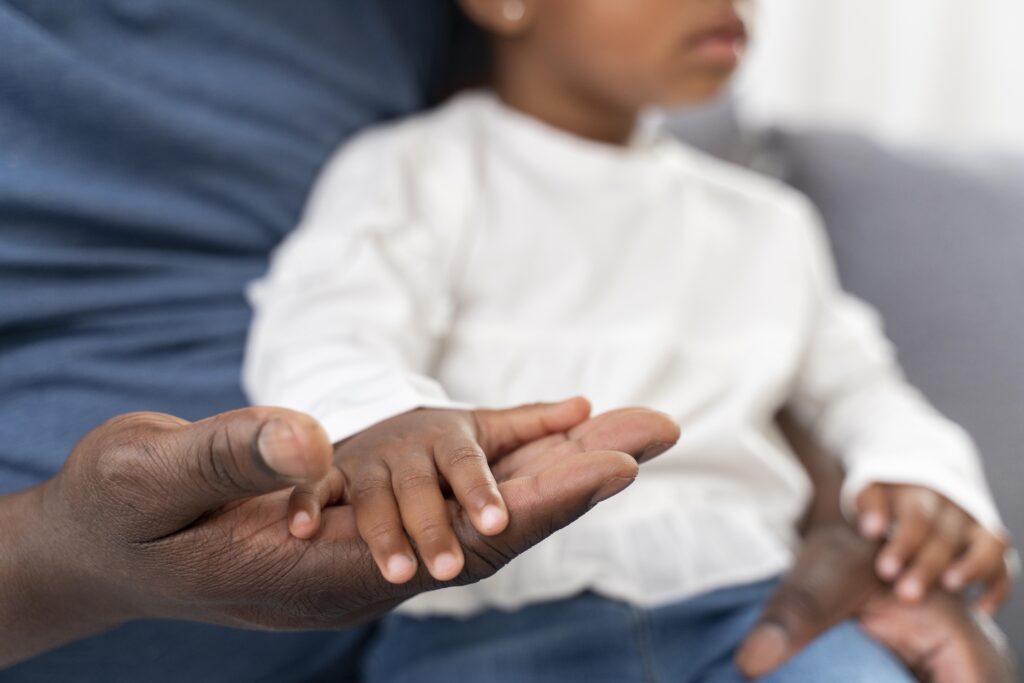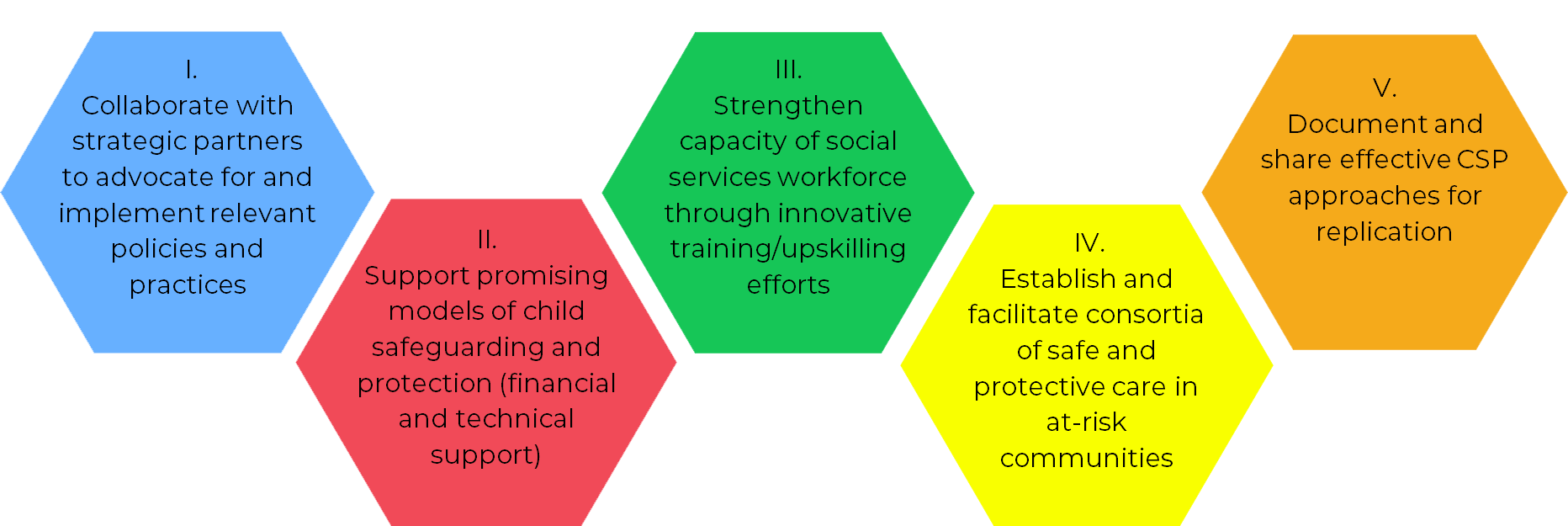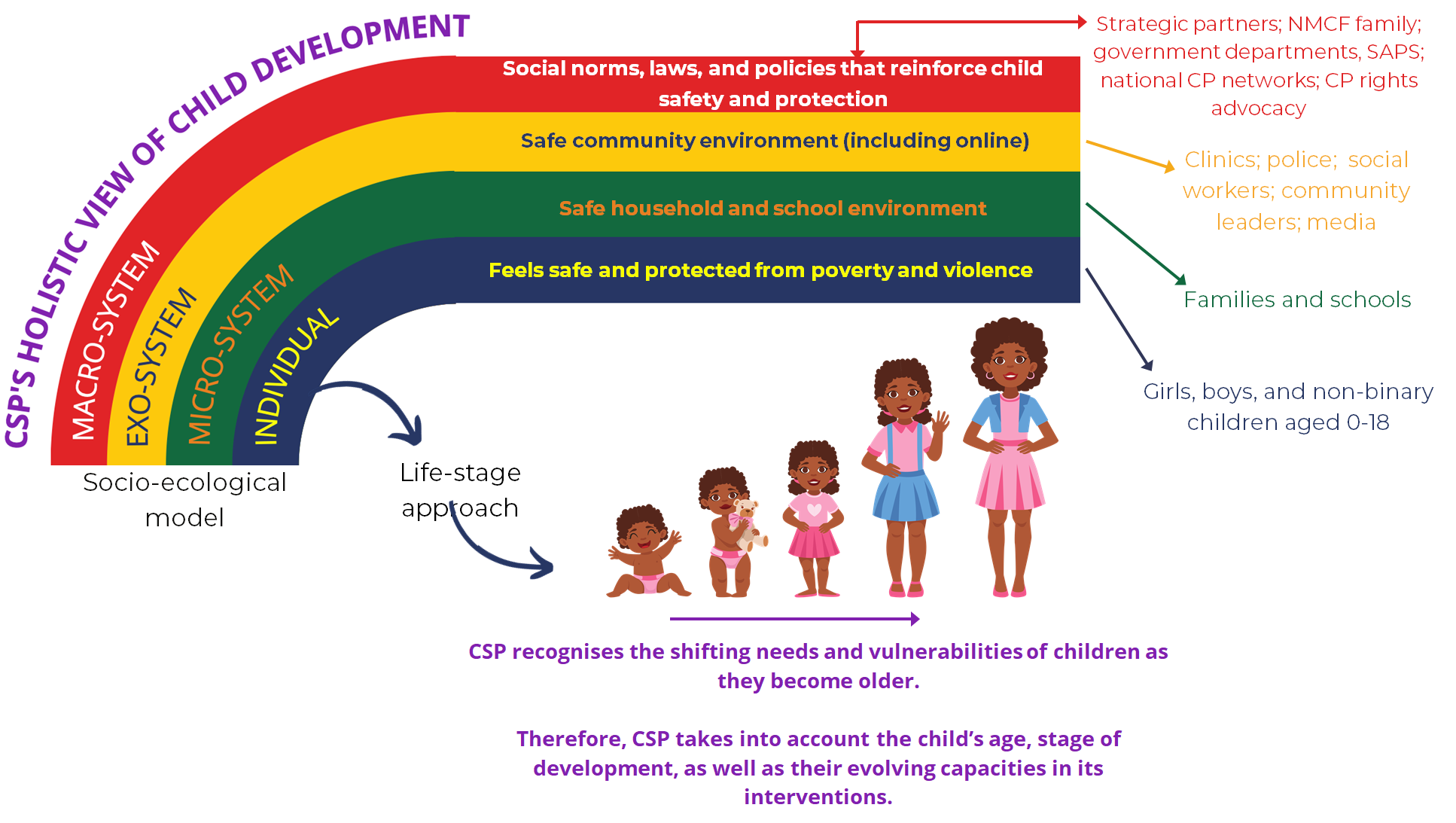Programme Overview
The Nelson Mandela Children’s Fund (NMCF), through the Child Safety and Protection (CSP) Programme, has been contributing to solving child protection challenges for South African children for more than 25 years. The main goal of the CSP programme is to ensure the safety and protection of children (aged 0-18) in the areas where they live, learn, and play (i.e., home, school, and community). To do so, it focusses on areas with a high prevalence of violence against children (VAC) and employing the following core components:
![]() learning and quality improvement of implementing partners (IPs);
learning and quality improvement of implementing partners (IPs);![]() community building (establishing and facilitating child protection consortia);
community building (establishing and facilitating child protection consortia);![]() capacity development (delivering accredited child protection training to the child protection workforce); and
capacity development (delivering accredited child protection training to the child protection workforce); and![]() advocacy.
advocacy.

The first two components will be achieved through grant agreements with IPs in priority districts, while the latter will be achieved through the CSP programme team in collaboration with strategic partners. Thus, the central premise is that if the CSP programme provides financial and technical support to IPs and the child protection workforce, establishes child protection consortia, and promotes advocacy, then there will be increased child safety and protection in families and communities.
Programme History
The CSP Programme exists to create protective environments that prevent and respond to abuse, neglect, and VAC in households, schools, and other spaces where children live, learn, and play. The CSP Programme aims to contribute solutions to ending VAC[1], particularly in communities in South Africa where crime statistics as reported by the South African Police Service (SAPS) indicate the greatest incidence. For this programme, ‘children’ and ‘violence against children’ are defined as follows:
![]() VIOLENCE AGAINST CHILDREN:
VIOLENCE AGAINST CHILDREN:
Any acts of emotional, sexual, or physical maltreatment, neglect, or abuse inflicted upon children by any person/s anywhere, including digital platforms.
![]() CHILDREN:
CHILDREN:
Girls, boys, and all persons of non-binary gender younger than the age of 18.
A graphical summary timeline of the CSP programme for the years 2016 to 2021 is provided below. For further detail on the history of the programme, refer to the CSP Critical Reflection and Review Document (2022).
[1] In previous documents this has been referred to as ‘Child Abuse’. However, violence against children (VAC) is a more comprehensive term which includes child abuse.
Grant disbursed:
R 27 243 732.00
– Focus on reducing corporal punishment in schools, decreasing sexual and gender-based violence amongst women and girls, and the elimination of bullying within schools
– Delivered in 5 provinces (Limpopo, Kwa-Zulu Natal, Eastern Cape, Western Cape, and Gauteng)
– Reached 40 schools and over 10 000 learners directly and indirectly, 250 educators, and 300 parents/guardians
School Safety Framework
– 53 schools assessed (Deloitte evaluation)
– 38 schools developed school policies to align with school safety frameworks
– ‘Adopt a cop’ initiative implemented in Western Cape to promote police protection of schools
– ADAPT and Afrika Tikkun developed safeguarding policy
Safety Nets
– Two pilot homes for destitute children that provide legal support & facilitate family reunification
Legal Support
– Fund involved with providing support to children who are forced into child marriages
Advocacy, Lobbying, and Convening:
– Implementing coalition’s provincial advocacy plans after training for implementing partners by Tshwaranang Legal Advice Centre
– Worked with Children Ambassadors using Declarations of previous Nelson Mandela Childrens Parliament outlining their demands and needs to SA leaders
– Best Market Practice – showcasing best approaches and methodologies used by coalitions for CSP
– PSS Forum in 2017, 2019, and 2021 convened by REPSSI
– Girls Symposium – showcase resilience of girls and boys in spite of the vulnerable situations they face in life
Capacity Building:
– Trained 24 facilitators in Gauteng and Limpopo
– 3 schools in Gauteng and 5 schools in Limpopo
– 320 learners in Diepsloot and 120 learners in Limpopo taken through ‘Empowering Girls’ and ‘Peace is a Decision’
Programme Focus
NMCF recognises there are numerous challenges the country and its people are facing. The organisation has identified the following most pressing challenges that it would like to contribute towards addressing:
The CSP programme will work with the other NMCF programmes and corporate services units to contribute to addressing the aforementioned priority challenges in the following ways:
Poverty
-
Prioritise IPs supporting resource-strained communities
-
Building a sustainable livelihoods component within every CSP project
-
Supporting the integration of CSP standards within the NMCF Youth Leadership Programme (YLP) and Sustainable Livelihoods Programme (SLP)
Child Mortality
-
Integration of CSP standards within NMCF Child Survival, Development and Thriving (CSDT) Programme
-
Early childhood development (ECD) experts and CSDT Programme to technically review CSP programme documents and advise on intervention designs to ensure inclusion and participation of children under-5 and their caregivers
-
Supporting innovative adolescent sexual and reproductive health (SRH) programmes and services
Youth Unemployment
-
Conduct annual child safety campaigns for households and early childhood development (ECD) centres
-
Including Youth Leadership and Empowerment experts and NMCF Youth Leadership Team to technically review CSP documents and advise on intervention designs to leverage opportunities for strengthening youth entrepreneurship and employability skills
-
Maximising youth participation in the sustainable livelihoods components of CSP projects
Violence against Children
-
Provide programmatic leadership in NMCF Legacy in Action Strategy Child Safety focus area
-
Systematically work to reduce child vulnerability to abuse, neglect, and violence in homes, schools, and other spaces (including digital) that children live, learn, and play
-
Employ 5 key strategies
Key Strategies
The key strategies that CSP will employ to address violence against children are:

Conceptual Frameworks
Programme specific description of conceptual frameworks
The CSP Programme is underpinned by a theoretical framework which:
Implementing Partners
The implementing partners will operate in the following priority districts. As illustrated in the map below, a total of 25 priority districts have been identified for the strategic period (2023-2027). A subset of 12 priority districts will be targeted in the first phase (2023) (green pins) and the remaining 13 priority districts will be targeted in the second phase (2025) (red pins). The priority districts specific to CSP for the first strategic period are shown in purple text.
















